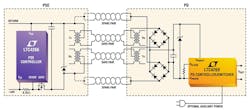Download this article in PDF format.
After its release as an IEEE standard in 2003, Power over Ethernet (PoE) has continued its upward spiral in performance, demonstrating an ability to transfer Ethernet data at faster speeds and dc power at higher levels—all in a single eight-wire bundle. And every enhancement to the standard adds to its popularity, so much so that most analysts project global revenue from PoE power-sourcing equipment (PSE) and powered devices (PDs) will reach at least $3 billion in 2025 from less than $1 billion today. To meet the challenge of the latest PoE standard, PSE equipment and the PDs themselves will need controllers capable of handling it.
When PoE emerged in 2003 as the IEEE 802.3af standard, only 13 W at 350 mA could be transferred over a distance of 100 m, which was sufficient for powering some VoIP systems, CCTV cameras, and RFID along with other types access control. However, devices such as videoconferencing, Wi-Fi routers, pan-tilt-zoom or heated cameras, and door interlock systems draw more current, so they were beyond the means of 802.3af to power them.
In 2009, the IEEE 802.3at enhancement was ratified, which increased power to 25.5 W at 600 mA, solving the problem for some of these systems. However, others were still tethered to the 120-V ac mains. The next version, 802.3bt, brings maximum power to about 90 W, which accommodates many more types of devices, including even cellular small-cell base stations. It should be ratified before the end of the year.
In addition, since PoE was first standardized, almost all electronic systems have become far more efficient, further adding to the list of potential PoE candidates. Thus, thanks to the increased power delivery of PoE combined with more efficient devices in general, 802.3bt should significantly boost PoE’s popularity in the future.
Sponsored Resources:
- LT4275 PD Controllers
- LTPoE++Controller Family
- Power over Ethernet Solutions for Smart Building Applications
Facilitating the Smart Building
One of the key target markets for 802.3bt is the so-called “smart” building, as it incorporates a significant portion of the devices that can be PoE-powered. It also offers the added benefit of allowing every one of them to have its own IP address. The latter will be enormously important in these buildings, which will incorporate hundreds or even thousands of sensors and all must be monitored and controlled from a single management system, either locally or virtually anywhere via the internet.
1. The Edge in Amsterdam represents the state of the art in smart, green building design, and PoE is contributing to its efficiency. (Source: buildup.eu)
For several years, the gold standard in such buildings has been The Edge in Amsterdam, the Netherlands (Fig. 1). The 430,500 ft.2 building is considered the smartest and greenest building in the world and a true engineering marvel. The building has more than 28,000 sensors of every imaginable type—all managed by a single system—and has the highest BREEAM score ever achieved of 98.36% BREEAM, or the Building Research Establishment Environment Assessment Methodology, is the world's longest established method of assessing, rating, and certifying the sustainability of buildings.
The Edge uses 70% less electricity than a typical office building, producing more energy than it consumes. It even reuses rainwater to flush toilets and water plants in and around the building. Among its many leading-edge features is its PoE-powered lighting system designed by Phillips. It allows employees to personalize both the lighting and temperature of their workspaces with a smartphone app while also collecting data on the workspace environment to reduce energy consumption. Other data-intensive systems in the building use PoE as well.
Controllers for High-Power Apps
Of course, the ability to handle higher power requires device controllers that can meet this requirement, and in this regard the electronics industry is far ahead of the standard itself. For example, Linear Technology (now part of Analog Devices) created its LTPoE++ technology (Fig. 2) nearly a decade ago; it uses proprietary signaling techniques to achieve a maximum power level of 90 W. LTPoE++ has been used in the company’s controllers since then, and it was one of the key drivers of 802.3bt standard development.
2. Analog Devices’ LTC4266 PSE controller and LT4269 PD controller with integrated switchers represent a cost-effective solution based on LTPoE++ for powering wireless access points, pan/tilt/zoom security cameras, and RFID readers.
The LT4295 is a good example of an LTPoE++-based PD controller designed to meet the needs of high-power applications such as wireless data systems, outdoor security cameras, public information displays, and any other system drawing up to 71 W. It has efficiency greater than 94%, supports auxiliary power up to 9 V dc, and is housed in a 4 × 4 QFN package. At the PSE side, the LTC4270 has 12 channels and comes with power outputs ranging from 13 to 90 W. Transformer-isolated communication protocol eliminates the need for up to six optocouplers and an isolated 3.3-V dc power supply.
Now that PoE has achieved the ability to power a huge variety of sensors and other data-generating devices, the next question is arguably “What’s next?” The answer is probably at least several years away, as 802.3bt is just now being released (although Linear Technology and others have years-old proprietary solutions).
As with all technology advances, 802.3bt will need to prove it can deliver on its promise while handling more dc power than its predecessors, while keeping heat generation in check, along with other potential problems. However, thanks to IoT, there’s no shortage of “things” that PoE can power in the coming years.
Sponsored Resources:
- LT4275 PD Controllers
- LTPoE++Controller Family
- Power over Ethernet Solutions for Smart Building Applications
Related References:


